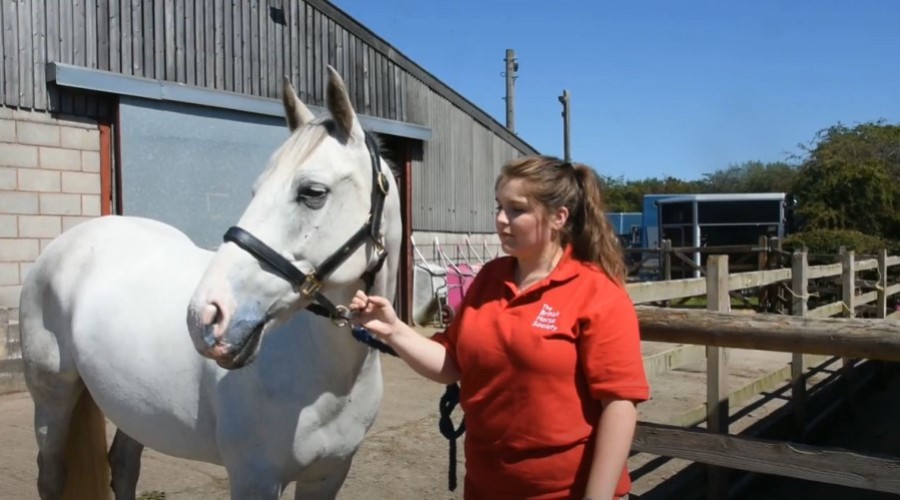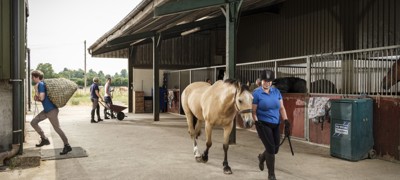Increase water intake
In hot weather, your horse will increase the amount of water they drink (for a 500kg horse this could be 50-70 litres or four-six buckets per day)1. If they don’t have access to enough water, it can increase the risk of dehydration. To prevent this, it’s vital that a constant supply of clean, fresh water is available. Exercising your horse in hot weather will further increase the amount of water they need.

Water has a key role in your horse’s digestive system, where it’s continually secreted into and reabsorbed from the gut. Changes in hydration, by not having enough water, can affect the digestive process and how food passes along the gut. This increases the risk of impaction colic which occurs when a firm ball of feed material blocks the intestine.
Soak or steam hay
chevron-down
chevron-up
Soaking or steaming your horse’s hay is a good way to add extra water to their diet, helping to prevent dehydration. Make sure to introduce any changes gradually to reduce the risk of colic.
Soaking
- Soak for 6-12 hours in clean, cold water or one hour in warm water2
- Less time is needed to soak when using warm water or during warmer weather to prevent mould and bacteria growth.
- Soaking hay will reduce the nutrient content of the hay. A vitamin and mineral supplement or balancer will help make sure the essential nutrients are provided.
Steaming
- Increases water intake while maintaining the nutritional content of hay3
- Can help reduce mould and bacteria3.
Water sources
chevron-down
chevron-up
- Aim to have more than one water source available and where possible, avoid corners of the field to prevent conflict between horses in shared fields
- Larger water containers such as a large water bucket or trough may encourage your horse to drink more than a small bucket or automatic drinker4
- Make sure containers are cleaned regularly to prevent algae and bacteria growth.
Flavouring
chevron-down
chevron-up
Adding a sweet flavouring to a bucket of water, such as apple juice, can help to encourage a reluctant horse to drink5. Make sure that your horse still has the option of plain water in case they don’t enjoy the flavoured water – we don’t want to unintentionally add to the risk of causing dehydration.
Use Enrichment
chevron-down
chevron-up
Enrichment creates a greater variety and choice, positively contributing towards a horse’s physical and mental needs.
Shelter
Shelter or shade is recommended in hot weather. If your horse is turned out, a field shelter provides the best protection from the sun and biting insects6. The shade provided by trees and hedges may provide a good substitute but remember it will move with the sun, so there may be certain times of the day when shade isn’t accessible to your horse. Natural shelter also may not provide shelter from biting insects. If you use natural shelter, be aware of poisonous trees and hedges which are unsafe for use around horses.
If you can, stabling horses through the hottest parts of the day, providing their stable remains cool and well ventilated, can be a good option to consider. However, inadequately ventilated stables can become uncomfortably hot and stuffy, and may have a negative effect on your horse’s physical and mental health7. Make sure you make any changes to your horse’s management gradually to reduce the risk of colic.
Flies
Flies and biting insects are more likely to be a problem for your horse in hot weather. To help reduce your horse’s exposure:
- Keep your horse in during the day and out at night
- Use thin fly sheets and masks
- Apply a fly repellent spray – always follow the manufacturers’ instructions and don’t use on inflamed or broken skin
- Remove droppings frequently from the paddock and housing
- Where possible, position the muck heap away from where the horse is kept.
Sun protection
Sun cream isn’t just for humans! Horses with pink skin and grey or white hair are most susceptible to burning so sun protection is highly recommended, especially on pink noses.
 play-circle
play-circle
Watch
Looking after your horse in the sun
Grazing
The hot weather may affect your grazing, as the sun can dry out the grass, effectively turning your grazing into hay. This grass will still provide enough calories for your horse; however, the nutritional value may decrease. A low-calorie balancer or vitamin and mineral supplement may be needed to make sure your horse is getting exactly what they need. A horse grazed on sun-dried grass doesn’t necessarily need additional forage assuming they’re not losing weight. Horses in medium-hard work might need additional calories.
If your horse is kept on a bare paddock, be aware they could consume more soil or sand, increasing the risk of colic. You may need to feed additional forage to help prevent this. Introduce any new forage gradually over a minimum of 10-14 days.
Assess the level of work your horse is in before giving additional forage, and fat score your horse to help assess whether they need any additional calories. Remember, your horse won’t burn as many calories through the summer, as they naturally would through colder winter months to keep warm.
Be extra careful if you own an overweight horse or a horse with an underlying condition such as Equine Metabolic Syndrome or Cushing’s Disease and rain is forecast. The combination of rain and sun will cause the grass to grow quickly and if you let your horse eat too much, this could increase the risk of laminitis. Be prepared to control grazing if rain is forecast and introduce your horse slowly back to what will be a very different forage compared to what they’ve been eating before the rain.
References
chevron-down
chevron-up
- Nyman, S. et al (2002) Water intake and fluid shifts in horses: effects of hydration status during two exercise tests - PubMed (nih.gov)
- Rendle, D et al. (2018) Equine obesity: current perspectives. UK Vet Equine. Vol 2.
- Moore-Colyer, M.J., et al (2016). The effect of steaming and soaking on the respirable particle, bacteria, mould, and nutrient content in hay for horses. Journal of Equine Veterinary Science, 39, pp.62-68.
- Harris, P.A. and Schott, H.C., (2013). Nutritional management of elite endurance horses. Equine applied and clinical nutrition. Health, welfare and performance. Saunders Elsevier, Edinburgh, UK, pp.272-288.
- Christensen, J.W., et al (2022). Shelter use by horses during summer in relation to weather conditions and horsefly (Tabanidae) prevalence. Applied Animal Behaviour Science, 253, p.105676.
- Van Diest, T. J., et al (2021). The effect of water flavor on voluntary water intake in hospitalized horses. Journal of Equine Veterinary Science, 98, 103361.
- Janczarek, Iwona, et al. (2020)Effect of air temperature and humidity in a stable on basic physiological parameters in horses. ANIMAL SCIENCE AND GENETICS3 55-65.
- Pritchard, J. C., et al. (2008): Validity of indicators of dehydration in working horses: A longitudinal study of changes in skin tent duration, mucous membrane dryness and drinking behaviour.Equine veterinary journal6 558-564.
Thanks to Dr Teresa Hollands, Senior Teaching Fellow (Veterinary Nutrition) at the University of Surrey for her assistance with the grazing advice, and Dr James Risk MRCVS for his assistance with the water increase advice.
Thanks to Dr Teresa Hollands, Senior Teaching Fellow (Veterinary Nutrition) at the University of Surrey for her assistance with the grazing advice, and Dr James Risk MRCVS for his assistance with the water increase advice.
Thanks to Dr Teresa Hollands, Senior Teaching Fellow (Veterinary Nutrition) at the University of Surrey for her assistance with the grazing advice, and Dr James Risk MRCVS for his assistance with the water increase advice.
Get in touch - we're here to help
The Horse Care and Welfare Team are here to help and can offer you further advice with any questions you may have. Contact us on 02476 840517* or email welfare@bhs.org.uk – You can also get in touch with us via our social media channels.
Opening times are 8:35am-5pm from Monday–Thursday and 8:35am-3pm on Friday.
*Calls may be recorded for monitoring purposes






